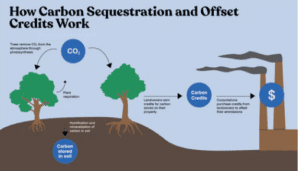A market-based tool for lowering greenhouse gas emissions, carbon credits in India have gained attention as part of the country’s transition to sustainable growth. Businesses, investors, and sustainability advocates now need to understand how carbon credits operate, as well as their advantages, rules, and practical effects, as global pressures and domestic climate targets increase. Let’s explore all you need to know about carbon credits in India and why, in 2025, they will be more important than ever.

What Are Carbon Credits and How Do They Work?
One metric ton of carbon dioxide or equivalent greenhouse gases (CO₂) is reduced by carbon credits,
which are tradable certificates. These credits can be produced by a company that reduces emissions above required thresholds. To comply, those who surpass their emissions cap can purchase credits. By providing incentives for carbon capture, afforestation, and clean energy, this system turns environmental stewardship into financial gain.
There are two primary frameworks under which carbon credits function in India:
- The Kyoto Protocol’s Clean Development Mechanism (CDM) allows Indian projects, such as wind farms, to earn Certified Emission Reductions (CERs), which are then purchased by buyers worldwide.
- Voluntary Carbon Markets: In order to achieve ESG objectives or improve their reputation, businesses voluntarily offset emissions through credits from domestic or foreign projects.
Why Carbon Credits Matter in India
India has one of the fastest-growing renewable energy sectors in the world, despite being one of the top emitters. Carbon credits are essential for: • Promoting investments in clean technology.
- Using biomass and agroforestry initiatives to promote rural prosperity
- Complementing India’s Paris Agreement climate targets, which include achieving net-zero emissions by 2070
Indian carbon credits have the potential to draw in foreign investment while benefiting regional economies and ecosystems, as demand for offsets rises globally.
Key Policies and Regulatory Framework
Government Regulators’ Function
CDM projects are managed by the Ministry of Environment, Forests, and Climate Change (MoEFCC). Voluntary programs are governed by the Environment Ministry and the Bureau of Energy Efficiency (BEE). To formalize domestic carbon markets and standardize certification, registries, methods, and compliance procedures, the draft Carbon Credit Regulation 2022 was introduced in 2024. For more info, https://cdm.unfccc.int/
New Mandatory Program
By 2025, India hopes to introduce its own Emissions Trading System (ETS) that will target major industrial emitters. This proposed system would create a domestic demand-driven market by requiring companies that exceed pollution thresholds to either reduce their emissions or buy credits.
Types of Carbon Credit Projects in India
- Wind and Solar Installations
 Examples: Large solar farms generating tradable credits via electricity generation that avoids fossil fuel use.
Examples: Large solar farms generating tradable credits via electricity generation that avoids fossil fuel use. - Biomass & Waste Energy
Examples: Power from agri-residue that substitutes for coal. - Afforestation & Reforestation
Examples: Tree-planting projects that sequester CO₂ while supporting local livelihoods. - Methane Capture
Examples: Coal mine gas capture and landfill methane projects, reducing climate-warming emissions.
These project types span major industries and regions, from Tamil Nadu’s wind belt to Uttar Pradesh’s biomass hubs.
Benefits & Challenges of Carbon Credits in India
Carbon Credit Benefits
In India, carbon credits are essential for advancing sustainable development. By implementing greener and cleaner technologies, they encourage industries to lower their greenhouse gas emissions. Sustainability is profitable because energy efficiency, afforestation, and renewable energy projects can produce carbon credits that can be exchanged for cash. In addition to drawing in foreign investment and encouraging green innovation across industries, this aids India in fulfilling its climate obligations under the Paris Agreement.
Carbon Credit Difficulties in India
Despite their potential, India facesseveralf obstacles in implementing the carb
on credits. Because the regulatory framework is still developing, businesses—especially small and medium-sized businesses—are hesitant to adopt it and are experiencing uncertainty. Awareness, technical know-how, and dependable infrastructure are lacking for accurate monitoring and verification of emission reductions. The efficiency and legitimacy of the carbon credit market in India may also be weakened by issues like greenwashing, uneven pricing, and low domestic demand.
Carbon Credits Marketplace and Pricing Trends
Voluntary carbon markets have gained popularity in India in recent years. Indian-origin carbon credits were made available to buyers worldwide in 2024 by Vibha Carbon, the Indian Renewable Energy Development Agency (IREDA), and a number of startups. In contrast to CDM CERs, which cost between ₹60 and ₹200 per ton, prices now range between ₹300 and ₹800 per ton, depending on project type and certification.
Prices are expected to stabilize between ₹500 and ₹1000/ton with the upcoming launch of India’s ETS, making participation more profitable for regional producers.
Case Studies of Successful Projects
Biomass Power in Karnataka
A biomass plant in Tumkur district sells credits to international buyers while reducing open-air burning and supporting local farmers.
Wind Farm in Gujarat
A large-scale wind project near Bhuj sells CERs internationally while contributing to India’s renewable energy target.
Mangrove Restoration in Sundarbans
A coastal afforestation initiative not only sequesters carbon but enhances biodiversity and climate resilience.
How to Participate in Carbon Markets
If you’re a business or investor:
- Start with a carbon footprint assessment
- Choose eligible carbon credit projects
- Navigate verification and certification (CDM or Verra standards)
- Buy or sell through exchanges like Climate Impact X (SGX) or Blinks Carbon (Mumbai)
For farmers or project developers:
- Register a suitable offset project (agroforestry, livestock methane, etc.)
- Partner with aggregators or developers to manage certification
- Ensure transparent monitoring and reporting to attract buyers
The Future of Carbon Credits in India
- Domestic ETS launch by 2025—driven by incoming policy
- Stricter corporate disclosure laws—tied to credit-based offsets
- Technological validation—with blockchain and satellite monitoring for transparency
- Community-centric models—to empower rural India as key stakeholders
India’s unique position—being both an emerging economy and climate leader—makes carbon credits a powerful tool to leverage economic growth and ecological resilience together.
Final Thoughts on Carbon Credits in India
In India, carbon credits are revolutionary because they convert the reduction of emissions into business opportunities. The mechanism balances profit and the environment through CDM legacy projects, developing domestic markets, and rural empowerment through green business. Even though there are still issues with pricing, policy clarity, and verification, the future appears bright, particularly with the introduction of a domestic Emissions Trading System (ETS) and growing demand from international buyers.
Indian companies, developers, and communities must continue to be flexible, open, and goal-oriented if they want to prosper. Because every credit, every project, and every person matters in the battle against climate change.
📩 Call-To-Action
Curious about offsetting your company’s carbon footprint?
👉 [Join the Green Ledger]—get monthly insights on carbon trading, renewable initiatives, and sustainability success stories in India.
Start today and be part of India’s green growth story

